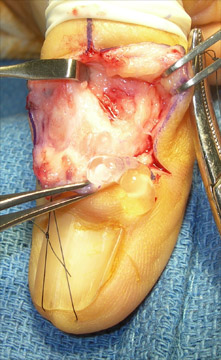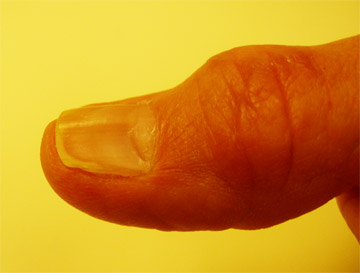Mucous Cyst

Mucous Cyst
Photograph courtesy of Dr. Burns
What is a Mucous Cyst?
A mucous cyst is a fluid-filled sack associated with arthritis of the DIP joint (the joint closest to the fingertip). It is only found in this location. It can often deform the fingernail or spontaneously drain fluid.
The sack is an outpouching of joint capsule, which is the sleeve of tissue that encloses a joint, keeping in the joint fluid. The joint fluid acts to both lubricate the joint as well as to bring nutrition to the cartlage. The cyst becomes filled with a substance that is similar in consistency to jelly or honey, that is, it is very thick (the technical term is "viscous"). The fluid is clear and contains the constituents of the joint fluid.
When to Treat a Mucous Cyst
A mucous cyst may be treated when they grow large enough to be ugle and obtrusive, or when they compress the cells which create the finger nail (called the "germinal matrix"), causing a nail deformity. Mucous cysts can a problem due recurrent episodes of draining. This can be a problem if the joint gets infected when normal skin bacteria enter the joint by climbing up the draining fluid. However, there is no absolute need to treat a mucous cyst, in the sense that displaced fractures need to be fixed. This is a case where the decision for treatment is more up to the patient, how big the cyst is, how much it gets in the way, is unsightly, recurrently drains, etc.
How do You Treat Mucous Cysts?

This is the incision for removal of
a mucous cyst. It is quite small, about
the size of your fingernail.
One form of simple treatment is aspiration of the contents, but this is only a temporary solution and I do not recommend it. They always come back, sometimes within days or weeks. Injection with steroids may improve the results of aspration alone, and in one study at the Mayo Clinic published in 2003 had a 60% success rate. This treatment has not been supported by more modern studies and is not recommended.
It is important that patients realize that stabbing it with a needle yourself seems like a great idea, but this is potentially a disaster. Even a needle that has been "sterilized" in a flame can lead to an infection either superficailly or involving the joint, and it is not uncommon for hand surgeons to see patients with infected joints who require hospitalization, IV antibiotics, and several surgeries, eventually requiring a joint fusion. The simple answer is: don't stick your mucous cyst with a needle.
Excision (surgically removing it) is a more aggressive treatment (requires an out-patient, in-and-out surgery) with a better chance at preventing the cyst from coming back. Recurrence does happen (about 10% or less), and is usually related to worse underlying pathology (arthritis). A definitive surgery (this means the cyst will never come back) is fusion of the joint. The position of the finger at the DIP joint (the one next to the nail) will not move, but since this joint moves the least of all the finger joints, it does not decrease hand function.
![]()
Here is an example of a mucous cyst. The patient has had a growth on the thumb for many years. It is growing slowly and now has created a groove in the nail:

The purple lines outline the surgical incisions. Here is what the cyst look like:

Note the clear, rounded masses at the bottom of the incision.

The masses have a thick, clear fluid inside of them.
The surgery included removal of the cysts, the excess synovial tissue (this is the tissue that makes the joint fluid), and the bone spurs (osteophytes) that also help to create the cysts.
Here is the same patient two months after the surgery above. The incision healed nicely. The patient required no Vicodin after surgery, just Tylenol Arthritis and Celebrex (see Dr. Nelson's pain management protocol; Dr. Nelson is the only hand surgeon in the US who is a member of the International Association for the Study of Pain, and has presented his post-operative pain managment research at their international meeting). Notice how at two months the nail plate is beginning to grow in, and that the nail shape is normal at its base.


The nail will take about 4-6 months to grow back in. At this point in time, it has grown in about 3/8 inch from the germinal matrix, back under the nail fold.
![]()
If you would like to read what some patients have written about their experience having their cysts removed surgically, click here (not yet posted).
